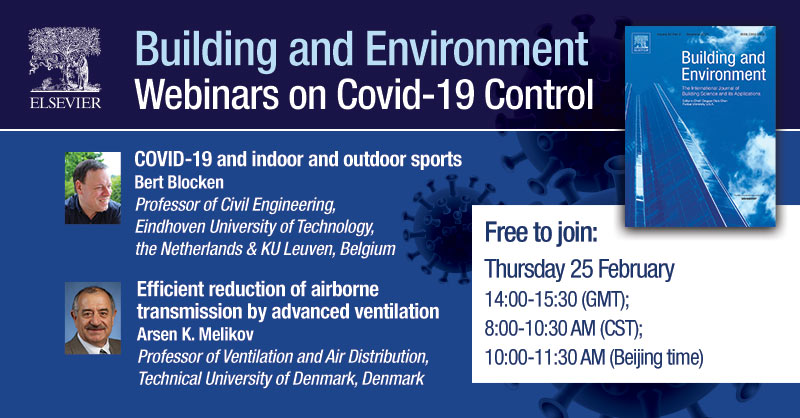
There will be 2 presentations in this second webinar of the series on COVID-19 control, followed by a Question and Discussion session:
COVID-19 and indoor and outdoor sports, presented by Bert Blocken, Professor of Civil Engineering, Eindhoven University of Technology, the Netherlands & KU Leuven, Belgium.
Abstract: Within a time span of only a few months, the SARS-CoV-2 virus has managed to spread across the world and it intends to be here to stay. This virus can spread by close contact, which includes large droplet spray and inhalation of microscopic droplets, and by indirect contact via contaminated objects. This presentation addresses large droplet and aerosol dispersion in outdoor and indoor environments, associated with different types of sports activities or scenes. First, droplet and aerosol spreading in running and cycling is analyzed, and the associated remarkable absence of common sense in times of the COVID-19 pandemic is addressed. Second, a strategy is proposed to safely re-open and keep open indoor sports centers during the COVID-19 pandemic. Third, some recently realized and ongoing practical research projects are briefly outlined, including the measurement and reduction of aerosol concentrations in a fitness center, the measurement and reduction of aerosol concentrations in the team bus of a professional cycling team for the past Tour de France and a project on aerosol assessment and concentration reduction in football stadia.
Efficient reduction of airborne transmission by advanced ventilation, presented by Arsen K. Melikov, Professor of Ventilation and Air Distribution, Technical University of Denmark, Denmark.
Abstract: The guidelines for reduction the risk of airborne transmission of COVID-19 recommend a substantial increase of ventilation indoors. However, existing ventilation systems, designed to operate under conditions without pandemic, allow for little increase of the ventilation rate. The mostly used at present dilution ventilation, aiming at mixing the supplied clean air with the polluted air in the entire volume of the space, is inefficient for reduction of airborne transmission. Paradigm shift from ventilation of entire space to occupant focused ventilation is needed. Source control and advanced air distribution will make it possible to control contaminant exposure of occupants and to efficiently reduce the risk of airborne cross-infection. This will be discussed during the presentation. Examples of advanced ventilation solutions for reduction of the airborne transmission of COVID-19 in office buildings, vehicles, healthcare facilities, etc. will be presented.
For more information please see here: https://www.journals.elsevier.com/building-and-environment/webinars or to register directly for this webinar please go here: https://researcheracademy.elsevier.com/workshop/f0f12b5b-a950-4220-b2af-4f63d6cdcc99
